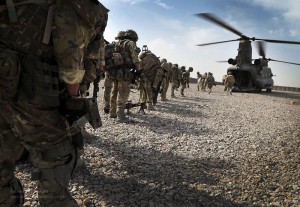Originally published in OtherWords.
The 10th anniversary of the 9/11 attacks is sure to bring televised images of somber reflection. Looking back is, in some ways, easier for commentators and pundits than wrestling with the current state of Washington’s so-called “war on terror.”
The United States is mired in two major wars in Iraq and Afghanistan, along with undeclared drone bombing campaigns in Pakistan, Yemen, and Somalia. Launching these wars was fairly easy for the White House, with or without congressional approval. How any of them ends, though, remains unclear. Even the NATO war in Libya, which by many accounts has “ended,” could become more chaotic and bloodier in the very near future.

(Defence Images / Flickr)
The shift from Washington’s time-limited military adventures that followed the Vietnam War — the relatively brief conflicts in Grenada, Panama, Somalia, and Kosovo, for example — to today’s seemingly interminable and endlessly multiplying military commitments is one of the most notable, yet little noted, features of the post-9/11 landscape. Regrettably, too many mainstream journalists seem all too willing to encourage Washington’s new “permanent war” footing.
The Iraq War, we’ve been led to believe, is the one that’s ending, if it’s not already over. Last summer’s withdrawal of combat troops was treated in the press as the conclusion of a very long war. But this summer the news tells a different story: Obama administration officials are lobbying the Iraqi government to hammer out an agreement that would allow U.S. troops to stay beyond the end of the year.
One newspaper called this a “vexing problem” for President Barack Obama, since he’ll have to explain why he’s extending a war he vowed to end. And recent upticks in bombings in Iraq inevitably trigger worry about how dangerous it will be for U.S. troops to leave. This is a strange conclusion, given that this violence is happening while troops are on the ground, and, of course, much of the violence in Iraq is a result of U.S. troops being there in the first place.
Similarly confused rhetoric defends the U.S. war in Afghanistan, where readers are asked to wonder what sort of horrors would take place if U.S. troops were to leave. The White House has a “withdrawal” plan, we’re told; “Obama Moves toward Exit from Afghanistan” was one headline after he gave a speech this summer. A newspaper article called it the “beginning of the end” of the war.
But the facts tell a different story: Even if the White House withdraws troops according to its proposed schedule, by 2012 the number of U.S. troops still fighting that war will be higher than when Obama took office. It’s downright strange to call that the “end” of anything.
Never-ending war has a domestic component too, of course. Massive police and law enforcement resources have been dedicated to racial and ethnic profiling, along with dubious terror “busts” that often turn out to be little more than schemes to goad people into talking about taking actions they probably wouldn’t undertake on their own. As Mother Jones magazine recently revealed, many of the domestic terror prosecutions since 9/11 have been the result of a dramatic increase in the use of informants and undercover operatives posing as would-be terrorists seeking to incite others to action. But each new “terror bust” is treated as big news, one more victory in the “War on Terror.”
After a decade of false alarms and fizzling terror plots, you’d think the media would be more skeptical of government warnings — and perhaps even exercise a little restraint. But then in July came word of a new al-Qaeda threat: terrorists who will sew explosives inside themselves. It was dubbed a “nightmare scenario” on NBC Nightly News. More cautious analysts pointed out that the difficulties in actually pulling off such a stunt would be considerable. But in a seemingly endless war on terror, media caution and skepticism are still in short supply.

